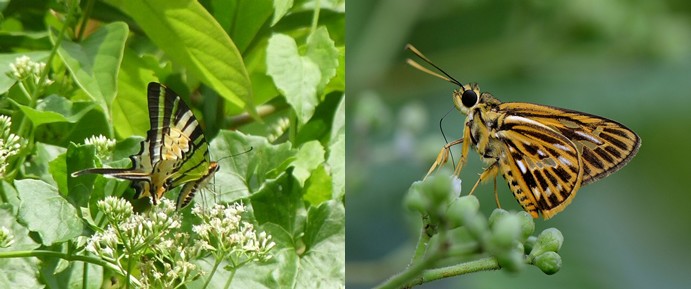Diet of tropical butterflies
NUS scientists have found that most tropical butterflies tend to feed on a variety of flowers but some species are very selective in their diet.
Flower-feeding ecology is a critical component of butterfly life-history that affects important traits such as fecundity (ability to reproduce), longevity and dispersal patterns. Research efforts to understand the flower-feeding ecology of butterflies have so far focused on those living in the temperate regions. The situation may be different in the tropics due to different evolutionary pressures (such as vertical complexity in tropical forests).
Butterflies are classified into three broad categories, depending on the number of flower types they feed on: (i) flower generalists (feed on many flower types), (ii) intermediates or (iii) specialists (feed only on a few flower types). A research team led by Prof Edward WEBB and comprising his Ph.D. student, Mr Anuj JAIN from the Department of Biological Sciences, NUS showed that most local butterfly species are “flower generalists” which feed on a broad range of flowers. They found that “flower specialist” butterflies used significantly higher proportions of native flower species in their diet than “flower generalist” butterflies and they tended to be more forest dependent. Some of these butterflies are critically dependent on single native flower types. For example, the Yellow Vein Lancer (Pyroneura latoia) butterfly feeds exclusively on flowers of Leea indica in 74% of feeding observations.
An understanding of flower specialisation (how many flower types the butterfly feeds on) across many butterfly species is necessary because butterflies are important pollinators, and therefore contribute to plant reproduction in tropical forests. Continued deforestation and habitat degradation in tropical forests have led to changes in vegetation structure that may facilitate increased abundance of non-native flowering plants. Understanding flower use dynamics in local landscapes has important implications for understanding potential changes in pollination and plant reproduction in local tropical forests.
This research explored an important aspect of butterfly ecology – flower use in forest and urban habitats. It also showed that flower use differed between forests and urban parks and the response of butterflies was species-specific – some reduced their diet by becoming more flower specialised, some benefitted from non-native nectar plants by expanding their diet while others showed no change in their diet response.
The research could be expanded to study the impacts of foraging shifts on seed production, seed dispersal and establishment. Community-level experiments involving multiple plant types over the entire plant reproduction cycle may be required to get a better understanding of the true costs and benefits of non-native plant species to butterflies in tropical forests.

(Left) A forest butterfly Five Bar Swordtail (Graphium antiphates) is seen feeding on a common non-native vine Mile-a-minute (Mikania micrantha). This photo shows a classic case of a forest butterfly feeding on a non-native flowering vine. [Image credit:Lena CHOW]
(Right) A forest butterfly Yellow Vein Lancer (Pyroneura latoia) butterfly seen feeding on flowers of Leea indica. This is the case of a flower-specialised forest butterfly critically dependent on one flower species. [Image credit: TEA Yi Kai]
Reference
Jain A., Kunte K., Webb E. L. “Flower specialization of butterflies and impacts of non-native flower use in a transformed tropical landscape”. Biological Conservation 201: 184 – 191 (2016). http://dx.doi.org/10.1016/j.biocon.2016.06.034
